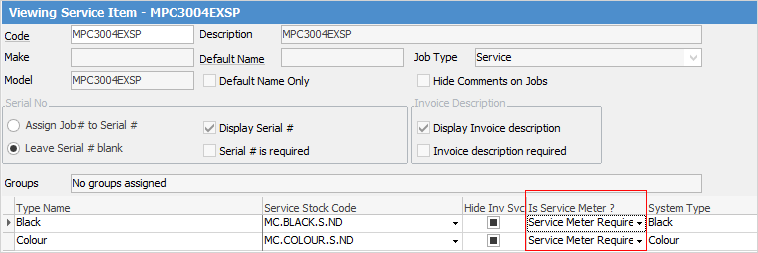
On the ribbon, go to Tools > Setups > Contracts > Page Source. Here is where all meter read request (page source) types are, including any MPS Connectors that are set up to use. The MPS Connectors will autopopulate once set up via the Jim2 Configuration Manager.

 |
New page sources cannot be added, as these are all system generated, however existing ones can be edited, including those with values between < > which are system defaults. |
Field |
Explanation |
|---|---|
Page Req Name |
The name that will flag what kind of page request it is, ie. from Canon eMaintenance or a generic CSV file, etc. This can be changed to something more suitable if required. |
Type Name |
This will automatically populate with the actual Page Req Name as set up in Jes, and is not editable. |
Job Source Name |
Shows where the meter reads come from, ie. an MPS Connector, web site, etc. |
Exclude Meter Reads Older Than (days) |
The number of days entered here signals to Jim2 to exclude meter reads that are older than the number of days entered here. This is populated from what is set up in Jes. |
Meter Read entry period (days) |
This number flags the entry period allowed, ie. within 5 days, etc. |
Values between < > indicate system default is used |
Appears in the footer next to the Close button. Means that the values found have been generated by the system, but can be edited.
 |
 |
This relates to MPS connectors and web meter reads only. There are two ways that Jim2 validates a meter read: 1.If it is for billing, Jim2 makes sure the meter read covers all the meter types on the Meter Setup tab for any related contracts. This is used for Record Read, Record Read, Try Billing and Billing submission actions. 2.A time and materials contract or an asset not on contract might not have any billing set up. In this case, it validates what meters are required against the Item’s meters. This is a Service Read scenario. For example, only the Black A4 and Colour A4 meters might be required. This type of validation is used for Record Service and Service.
Billing Read Validation Record Read validates required meters for an asset against the billing setup of any active contracts, but only records the read. No billing jobs are generated.
Record Read, Try Billing validates required meters for an asset against the billing setup of any active contracts. It also attempts to use this meter read to generate billing jobs/purchase orders. In the case of a child contract, it would record the read but the billing step would fail, as billing needs to occur from the master contract. This is used from an MPS Connector to record a read whether or not it can be used for billing, but it will try and use the read immediately to bill.
Billing validates required meters for an asset against the billing setup of any active contracts. This read is also used to generate billing jobs/purchase orders. The submission will fail if it cannot submit the meter read, or it was unable to generate billing jobs and purchase orders.
Service read validation Record Service validates required meters for an asset against the Item meter setup (below, black and colour reads are both required). The read is just recorded.

Service validates required meters for an asset against the Item meter setup. Where applicable, the service stock code is added to the current job and the macro evaluated.
If the set of meters required is the same between an asset’s Item and its related contract billing setup, there is no difference between a Record Read and a Record Service. They both end up in the meter reads table with identical values.
The differences relate to two things: 1.How is the read validated to make sure required meters are captured? 2.What do I do with a read once it has been validated?
Billing Contract Start will record the billing contract start reads. |
Is connector: |
Ticked if this is an MPS Connector, ie. FMAudit, Ricoh, etc. This entry cannot be changed. |
Further information